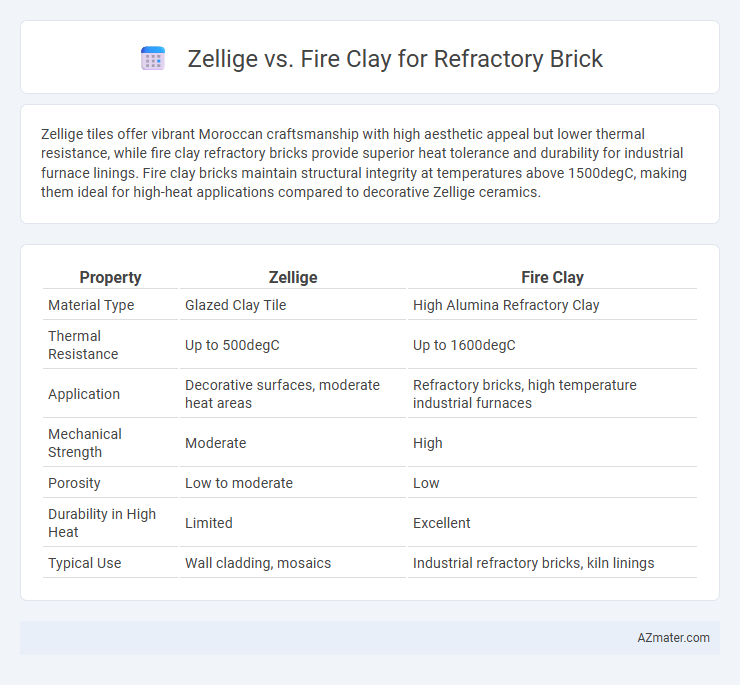Zellige tiles offer vibrant Moroccan craftsmanship with high aesthetic appeal but lower thermal resistance, while fire clay refractory bricks provide superior heat tolerance and durability for industrial furnace linings. Fire clay bricks maintain structural integrity at temperatures above 1500degC, making them ideal for high-heat applications compared to decorative Zellige ceramics.
Table of Comparison
| Property | Zellige | Fire Clay |
|---|---|---|
| Material Type | Glazed Clay Tile | High Alumina Refractory Clay |
| Thermal Resistance | Up to 500degC | Up to 1600degC |
| Application | Decorative surfaces, moderate heat areas | Refractory bricks, high temperature industrial furnaces |
| Mechanical Strength | Moderate | High |
| Porosity | Low to moderate | Low |
| Durability in High Heat | Limited | Excellent |
| Typical Use | Wall cladding, mosaics | Industrial refractory bricks, kiln linings |
Introduction to Zellige and Fire Clay Bricks
Zellige bricks are handcrafted Moroccan tiles made from natural clay, known for their unique glazed surface and vibrant geometric patterns that offer both aesthetic appeal and durability. Fire clay bricks, composed primarily of alumina and silica, withstand high temperatures and thermal stress, making them ideal for industrial refractory applications such as furnaces and kilns. While Zellige bricks emphasize decorative use in architecture and interior design, fire clay bricks focus on functional heat resistance and mechanical strength.
Composition and Material Properties
Zellige bricks are handcrafted from natural clay, characterized by their high silica and alumina content, which provides moderate thermal resistance suitable for decorative refractory applications. Fire clay bricks consist primarily of kaolinite, mullite, and other aluminosilicates, offering superior refractoriness with high thermal shock resistance and a melting point above 1700degC, ideal for industrial furnaces and high-temperature environments. The denser microstructure and lower porosity of fire clay bricks contribute to enhanced mechanical strength and durability compared to the more porous and aesthetic-focused Zellige tiles.
Manufacturing Processes Compared
Zellige tiles are handcrafted using traditional methods that involve molding, drying, and hand-glazing individual pieces, resulting in unique, artisanal surface textures. Fire clay refractory bricks undergo an industrial manufacturing process featuring high-temperature extrusion or pressing, followed by firing at temperatures exceeding 1,400degC to achieve exceptional thermal resistance and structural integrity. The artisanal Zellige process emphasizes aesthetic diversity and craftsmanship, while fire clay bricks prioritize consistency, durability, and optimal refractory performance through mechanized production techniques.
Heat Resistance and Thermal Performance
Zellige tiles, traditionally crafted from natural clay and fired at high temperatures, offer moderate heat resistance suitable for decorative applications but are less optimal for extreme thermal environments. Fire clay refractory bricks, composed of alumina and silica with high heat tolerance, provide superior thermal performance, sustaining structural integrity at temperatures exceeding 1500degC. For industrial furnaces and kilns requiring robust heat resistance and long-lasting durability, fire clay bricks are the preferred choice over Zellige.
Aesthetic Differences and Design Options
Zellige tiles showcase a handcrafted, glossy surface with vibrant, varied hues and traditional Moroccan patterns, offering rich aesthetic appeal and unique artisanal character in refractory brick designs. Fire clay bricks present a more uniform, matte finish with natural earth tones, emphasizing durability and industrial elegance rather than ornamental variety. Design options in Zellige focus on intricate mosaic layouts and bold color contrasts, while fire clay supports functional, minimalistic, and heat-resistant applications in high-temperature environments.
Durability and Longevity in High-Temperature Applications
Zellige and fire clay differ significantly in durability and longevity under high-temperature conditions, with fire clay refractory bricks exhibiting superior thermal stability and resistance to thermal shock. Fire clay bricks, composed primarily of alumina and silica, maintain structural integrity at temperatures up to 1,600degC, making them ideal for furnaces and kilns requiring sustained high-heat exposure. In contrast, Zellige tiles, while aesthetically versatile, lack the requisite thermal endurance and mechanical strength for rigorous industrial applications.
Cost Considerations and Availability
Zellige tiles generally have higher costs due to artisanal production and limited availability, making them less common and more expensive in refractory applications. Fire clay refractory bricks are more widely available and cost-effective due to mass production and abundant raw materials, offering a practical choice for high-temperature environments. Budget constraints and project scale often favor fire clay bricks for cost-efficiency and accessibility in refractory construction.
Maintenance and Installation Requirements
Zellige tiles require skilled artisans for precise installation due to their handmade, irregular shapes, and grout lines demand regular cleaning to maintain their distinct aesthetic. Fire clay refractory bricks offer easier installation with uniform dimensions and can withstand higher temperatures, reducing maintenance frequency in industrial environments. Both materials benefit from periodic inspections, but fire clay bricks generally require less upkeep due to their durability and resistance to thermal shock.
Suitability for Refractory Applications
Zellige tiles, primarily made from terracotta and known for their glazed surface, lack the high-temperature resistance and mechanical strength required for refractory applications, making them unsuitable for environments exceeding 1000degC. Fire clay bricks, composed of alumina and silica with excellent thermal shock resistance and stability at temperatures up to 1600degC, are specifically engineered for refractory use in furnaces, kilns, and fireplaces. Their high compressive strength, low thermal expansion, and ability to withstand chemical corrosion make fire clay bricks the preferred choice for industrial high-heat applications.
Summary: Choosing the Right Brick for Your Project
Zellige offers a handcrafted aesthetic with moderate heat resistance, making it ideal for decorative applications in fireplaces or low-temperature ovens. Fire clay refractory bricks deliver superior thermal stability and durability, suitable for high-temperature industrial furnaces and kilns. Selecting between Zellige and fire clay bricks hinges on balancing visual appeal against required thermal performance for your specific project needs.

Infographic: Zellige vs Fire Clay for Refractory Brick
 azmater.com
azmater.com